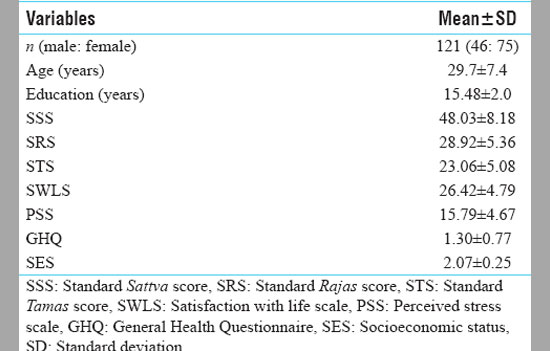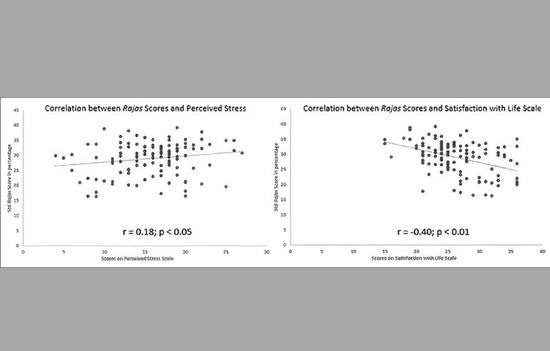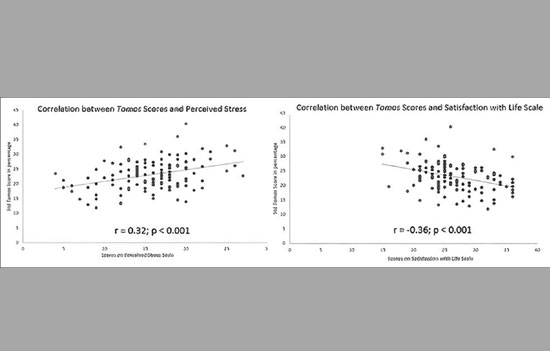- This
cross-sectional study assesses the relationship between Vedic personality
traits (Sattva, Rajas, Tamas) to life satisfaction and perceived stress in
healthy university students.
Abstract
Introduction: Trigunas are three basic mental
attributes of a personality according to Indian Vedic literature that
explains the relationship between mental attributes and human behavior. The
three attributes are Tamas (tendency
toward lethargy and rigidity), Rajas (tendency
toward ambition and activity) and Sattva (tendency toward selfless service), respectively. Satisfaction with life and perceived stress are the important determinants of one's quality of life.
Aim: A cross-sectional study assessed the relationship between Trigunas, life satisfaction and perceived stress. Materials and methods: The study recruited 121 willing healthy university students (75 females) with general health questionnaire scores ≤3. All participants were assessed using standardized psychometric tools.
Results: Spearman two-tailed correlation test revealed Sattva to have positive correlation with life satisfaction (r = 0.503) and negative correlation with perceived stress (r = −0.302) and other two Gunas (Tamas: R = −0.77; Rajas: R = −0.75), respectively. On the other hand, both Rajas and Tamas correlated positively with perceived stress (Rajas: R = 0.183; Tamas: R = 0.321) and negatively with life satisfaction (Rajas: R = −0.40; Tamas: R = −0.36).
Conclusion: This cross-sectional study on university students in India suggests an association of Vedic personality traits (Sattva, Rajas and Tamas Gunas) with life satisfaction, and perceived stress.
Introduction
Psychologists
over the years have defined human personality using many models and theories.
Vedic literature (Sankhya Yoga) and the Indian spiritual text “Bhagwad Gita” provide the basic framework for the concept of Indian psychology based on the relationship between yoga-based mental attributes (Gunas) and human behaviour. Vedic literature describes three Gunas - Sattva, Rajas and Tamas, representing illumination, activity, and inertia, respectively. These are the three fundamental qualities of human personality.[1]
Sattva is the
quality of intelligence that creates harmony, balance, and awakening[2] and generates tendencies toward selfless
service, disinterested affection, purity of heart, control over senses,
truthfulness and compassion toward other beings.[3] Rajas is the quality of action,
passion, and change.[2] It brings forth
the characteristics of ambition, restlessness, discontentment, envy and
sensuousness along with positive qualities of constructivism, passion,
industriousness and enthusiasm.[3] Tamas is the quality of dullness,
ignorance, fear and inertia.[2] It brings
a state of mental rigidity, apathy, delusion and destruction.[3] The
three tendencies promote different temperaments, leading to the formation of
personality based on the Guna dominance.[4]
In Ayurveda, Trigunas constitute
the integral component of the mind just as Tridoshas (Vata, Pitta and Kapha) constitute the integral component
of the human body.
The two forms the
physical and mental characteristics of an individual influence health and
disease, respectively. It has been stated in Ayurveda texts that vitiation
of Rajas and Tamas Gunas lead to mental health problems
which in turn influence physical health (Ch. Vi. 6.8).[5] Previous
studies have observed that individuals with Sattva Guna predominance
have better quality of life than those
with Rajas or Tamas predominance.[6],[7] Similar
studies on healthy subjects have reported well-being to have positive
correlation with Sattva and negative correlation
with Rajas and Tamas.[8]
Quality of life of
an individual depends on many factors, of which psychological stress[9] and satisfaction with life[10] play an important role. Both
these factors have also been identified as vital contributors in increasing
morbidity and mortality due to common lifestyle-related disorders.[9] Still how
stress and satisfaction with life is perceived by individuals with
different Vedic personality traits is not known.
Based on the
descriptions in yogic literature (BG: 14),[3] we
hypothesized that Sattva traits would correlate positively with life
satisfaction and negatively with perceived stress, and that this relationship
would be reversed for Rajas and Tamas traits, respectively.
Understanding this is important, as traditional Indian texts provide ways and
specific lifestyle regimen to enhance well-being and promote growth of
personality through transformation
of Gunas from Tamas to Rajas and Rajas to Sattva.[11]
Thus, this study was planned with the objective to find out how “Trigunas” are related to life satisfaction and perception of psychological stress.
Material and Methods
Study design
The
study followed cross-sectional design and convenient sampling for recruitment
of subjects.
Settings and participant details
including Sample size
The study was conducted at one university of South India. University students were invited to participate in study through the display of research study flyer in University campus. One hundred and fifty students willing to participate in the study were screened over a period of 2 months. Out of 150, 121 participants fulfilling the inclusion criteria were recruited. Only healthy participants in the age range of 18–45 years with a General Health Questionnaire score ≤3 were included and subjects with any comorbid psychiatric and physical illnesses or history of any kind of substance use were excluded from the study. Written informed consent was taken and institutional ethical clearance (IEC-MU/173/2019) was obtained.
Outcome measures
For
assessment, standardized psychometric tools were used.
Vedic Personality Inventory for assessing Guna
scores
Vedic Personality
Inventory (VPI) is a validated and reliable tool extensively used for
assessing Trigunas.[12] It is a self-reporting tool with 56
items with seven response to choose from (ranging from 1 - completely disagree
to 7 - completely agree). It is freely available online (http://www.vedicpersonality.org/questionnaire.php?name=)
and it automatically calculates Standard Guna scores.
This
is calculated by dividing individual Guna scores with total score and
multiplying it by 100. Thus, scores
of Sattva (S), Rajas (R) and Tamas (T) for each
individual are obtained in percentage in such a way that their total (S + R +
T) is 100%.
Perceived stress scale for psychological stress
Perceived stress scale (PSS) assesses nonspecific perceived stress, i.e., the degree to which situations in one's life is appraised as stressful.[13] It is a 10-item tool to be filled by the
subject. Its reliability and validity is established.
Satisfaction with life scale assesses life
satisfaction
Satisfaction with life scale (SWLS) is a 5-item scale recorded on a 7-point scale and helps in determining the overall quality of one's life by cognitive judgement of global life satisfaction.[14]
Data sources
All
the recruited participants were given the hand-outs of the three scales. For a
single time-point, they self-rated the scales post recruitment. The data were
then double entered in the Excel sheet.
Statistics
The scores obtained on the psychometric tools were not normally distributed; hence Spearman correlation test was used to assess the correlation with significance level set at 0.05. Data analysis was performed using the SPSS 24.0 (IBM India Pvt. Ltd., Bengaluru, Karnataka, India). Sub-group analysis was also performed with gender as covariate. The strength of association between two variables was labelled into three categories as strong (r > 0.6), moderate (r = 0.4–0.6), and weak (r = 0.2–0.4).
Participant characteristic
One hundred and twenty-one participants (46 males and 75 females) with a mean age of 29.7 ± 7.4 years participated in the study. All participants belonged to either middle or upper middle socioeconomic strata with average education of 15 years. [Table 1] provides descriptive statistics of
the sample population. [Figure 1] provides
average Guna scores of the recruited participants.
 Table 1-descriptive statistics of the study population.
Table 1-descriptive statistics of the study population.
 Figure 1-Gunas scores in healthy participants.
Figure 1-Gunas scores in healthy participants.
Correlation analysis results
The
results provided in [Table 2] show a moderate positive correlation between scores of Sattva with life satisfaction (r = 0.503, P < 0.001) and weak negative correlation of the same with PSS (r = −0.302, P < 0.001). On the other hand, both Rajas and Tamas show moderate to weak negative correlation with life satisfaction (Rajas: R = −0.40, P < 0.01; Tamas: R = −0.36, P < 0.001) and weak positive correlation with perceived stress (Rajas: R = 0.183, P < 0.05; Tamas: R = 0.321, P < 0.001). Within VPI measures, it was observed that Sattva had a strong negative correlation with Rajas (r = −0.751, P < 0.001) and Tamas (r = −0.775, P < 0.001), respectively. A weak positive correlation was found between Rajas and Tamas scores (r = 0.226, P < 0.01). In addition, a weak negative correlation was observed between SWLS and PSS scores (r = −0.254, P < 0.01). [Figure 2], [Figure 3], [Figure 4] provide graphical representation of
correlation results and [Figure 5] provides the graphical abstract
image.
For
Table 2, Figure 2 click on link
 Fig 3-Correlation results graphs for Rajas with perceived stress scale and satisfaction with life scale
Fig 3-Correlation results graphs for Rajas with perceived stress scale and satisfaction with life scale
 Fig 4-Correlation results graphs for Tamas with perceived stress scale and satisfaction with life scale
Fig 4-Correlation results graphs for Tamas with perceived stress scale and satisfaction with life scale
 Figure 5-Graphical abstract image.
Figure 5-Graphical abstract image.
Sub-group analysis
Sub-group
analysis based on gender revealed a slightly different association
between Guna scores and psychometric tools and within the Gunas,
respectively. The details of the sub-group analysis are provided in [Table 3] and [Table 4] in the supplementary material.
Table 3 and4 click on Link
It was observed that in males (n = 46), the strength of association between Gunas and psychometric tools (r = −0.254, P < 0.01) and within Gunas did not differ from overall results. However, among females (n = 75), the results were slightly different from the overall results. For example, in females, the PSS did not show significant correlation with Sattva and Rajas scores (Sattva: r = −0.191, P > 0.05; Rajas: r = 0.030 P > 0.05).
However,
weak positive correlation of PSS with Tamas scores remained in line
with overall results. Similarly, the positive correlation observed
between Tamas and Rajas Gunas in overall results as well as
in male subjects was not observed in the female subjects (r =
0.093, P > 0.05).
Discussion
This
is the first study to look at the association between Trigunas and perceived stress. We found a positive
relationship between perceived stress and scores pertaining to Rajas and Tamas traits, respectively. On the other hand, Sattva traits showed negative
relationship with PSS.
The finding of moderate correlation between Tamas traits and
perceived stress is in line with ancient yogic texts where individuals with
high Tamas Guna have
reported to perceive the situation as more stressful than reality.
As
per the Bhagavad Gita, Sattva relates to joy, positivity,
surrender to higher principle, and knowledge resulting in overall satisfaction,
whereas Rajas, the originator of desire leads to attachment and
frustration, and Tamas leads to ignorance and delusion.
Both (Rajas and Tamas) result in bondage and lead away from
happiness and satisfaction.[3] Previous
works on Triguna theory have also emphasized the superiority
of Sattva over Rajas and Tamas in terms of
well-being [15] and effective work culture.[16]
Further findings from the study show moderately positive correlation
of Sattva Guna with life satisfaction and strongly negative
correlation of the same with Rajas and Tamas, respectively.
The results of
this study replicate the findings from previous studies where healthy students
showed mild positive correlation of Sattva with life satisfaction and
subjective happiness and well-being,[8] and
negative correlation between Sattva and other
two Gunas (Rajas and Tamas),[8],[15] although the strength of the correlations in our
study is stronger. Previous studies have also shown a negative association
of Rajas and Tamas with well-being indicators.[8]
The
greater inverse relationship between Rajas and life satisfaction
possibly be explained by the logic that people with high Rajas tend
to have more expectations from their actions and have better insight into their
actions and sufferings than those with high Tamas. Thus, they feel less
satisfied, whereas those with Tamas predominance may remain
relatively passive and have less dissatisfaction.
The relationship between Rajas and Tamas is also in line with previous
studies, although the correlation in our study is weaker than shown earlier.[8] This difference in the intensity of correlations between studies may be due to the differences in population characteristics such as age range, gender, education and habits or it may have occurred just by chance (due to random error). For example, the current study had almost twice the number of females than males (male–46 and females–75).
Sub-group
analysis revealed that males showed moderate positive correlation
between Rajas and Tamas Gunas, but in female subjects, no such
correlation was observed. Previous studies, on the other hand, had either equal
distribution or more males.[8] Second,
participants with substance use were excluded which was not so in the previous
studies. In spite of these differences across studies among healthy
participants (across genders), Sattva Guna has shown a consistent
trend of negative correlation with Tamas and Rajas Gunas,
and Rajas and Tamas Gunas have shown a positive correlation
with each other.
A Shloka in Bhagavad
Gita describes that all three Gunas interact in such a way that
when one becomes dominant, the other two get subdued,[3] for
example, Sattva manifests by
overpowering Rajas and Tamas and vice versa for
other Gunas (BG: 14.10).[3]
This study could demonstrate the above verse in relation to Sattva with other two Gunas but not between Rajas and Tamas. Although a negative correlation was expected between Tamas and Rajas as per the ancient texts, instead a positive correlation was observed. This deviation can be explained by considering psychometric properties of the VPI tool: While generating normative data during standardization of VPI tool, Wolf et al. also observed a positive correlation between Rajas and Tamas Gunas.[12] The
way these Gunas are measured through VPI and their interpretation as
per the ancient texts may not match completely. A study with larger sample size
and wider population coverage may bring more clarity. This needs further
exploration in future studies.
As per Ayurveda, Prakriti (constitution)
of an individual is determined at the time of the birth of an individual, but
it also advocates the possibility of modification of the mental constitution
(Gunas) by following certain traditional lifestyle practices.
These
practices involve the components of Ahara (diet), Vihara (recreation and
sleep), Vyavahara (behavior)
and Vichara (cognition) and targets the modification of a particular guna. Ancient yogic texts have defined a fourth mental attribute called “Gunatita” (beyond Gunas). This is a state of mind where an individual transcends all the three Gunas. Such a state has been described as a state of freedom from all sorts of sorrows related to birth, death, old age and is characterized by equanimity of mind in all sorts of dualities such as pain or pleasure, blame or praise, disgrace or honour (BG. 14.20-25).[3] The natural process of spiritual evolution and psychological transformation involves transcendence from Tamas to Rajas, from Rajas to Sattva, and finally transcending all the Gunas to reach the state of “Gunatita” (BG 14.8-10).[11]
Similarly,
traditional yogic texts describe behavioural tendencies that are promoted by
different gunas. For example, Bhagwad Gita describes the dietary
preferences of individuals based on the dominance of a
particular Guna in their psyche.
These
tendencies may make an individual with a particular Guna dominance,
more prone toward a particular lifestyle disorder.
For
example, an individual with dominant Rajas Guna may prefer food items
that are more spicy and sour in taste. This may make them more prone for
stress, anxiety, and physical illnesses such as stomatitis, heart burn, etc.[17] (BG 17.9). Thus, understanding the
relationship between Vedic personality traits and determinants of
well-being is important, as overall well-being may be achieved and disorders
may be prevented by application of lifestyle regimen in accordance with the
dominant Guna traits of an individual.
The present study has several limitations: (1) relatively smaller sample size, (2) only student population is included, although they came from diverse regions, (3) all participants were recruited from a single university in South India, so generalization of the findings to other population cannot be done, (4) female predominance, (5) despite the use of validated scales, measurement bias in the responses cannot be denied due to the involvement of subjective opinion.
Conclusion
This
cross-sectional study on university students in India suggests an association
between Vedic personality traits of Sattva,
Rajas, and Tamas Gunas and satisfaction with life and perceived
stress.
Sattva trait
was associated with higher life satisfaction and lower perceived stress.
Both Rajasika and Tamasika traits were associated with
reduced life satisfaction and higher perceived stress. Rajas traits
showed greater negative correlation with life satisfaction
than Tamas traits, whereas Tamas traits showed greater
positive correlation with perceived stress.
Based
on this understanding, future studies should focus on assessing the impact
of Guna-based yogic lifestyle interventions on Vedic personality
traits and associated lifestyle factors in health and disease.
To
know References click here
or see article PDF
Source
of Support: None. Conflict of Interest: None.
Authors
are Shubham Sharma, Praerna Hemant Bhargav, Pooja Singh, Hemant Bhargav, Shivarama Varambally. To know about them Here
Article
available online/offline on: AYU, Vol. 42, Issue 1, January-March 2021, Page no
39-44, for more details please visit: www.ayujournal.org
Address
for correspondence: Praerna Hemant Bhargav
Department of Integrative Medicine, National Institute of Mental Health &
Neurosciences, Bengaluru 560 029, India.
No part of this article may be reproduced in full or part without written
permission of the Ayu Journal who can be contacted at ayujournal@yahoo.com
To read all articles on
Ayurveda